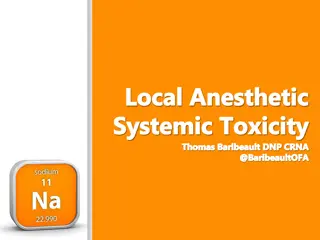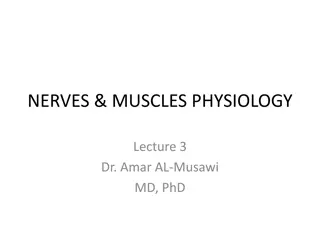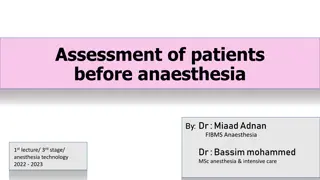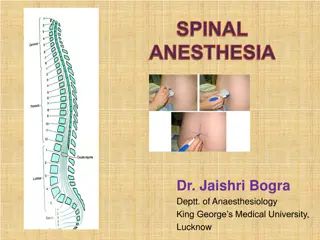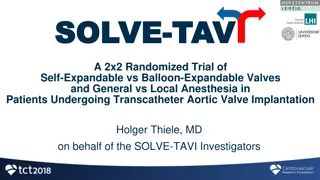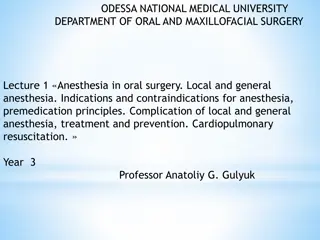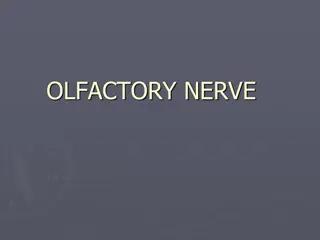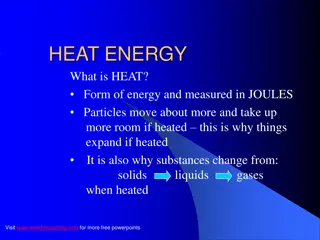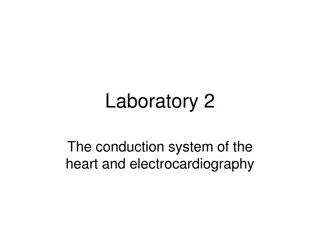Understanding Local Anesthesia and Nerve Conduction Blockade
Local Anesthetics (LAs) are drugs that abolish sensations like pain in specific body areas by blocking nerve conduction of sensory impulses. This process involves reducing the influx of sodium ions, preventing membrane depolarization, and inhibiting action potential conduction. LAs are weak bases with ionizable amine functions that can exist in nonionized and ionized forms, impacting their lipid solubility and activity levels. However, factors like acidosis from inflammation can affect the efficacy of LAs by hindering their ability to cross cell membranes.
Download Presentation

Please find below an Image/Link to download the presentation.
The content on the website is provided AS IS for your information and personal use only. It may not be sold, licensed, or shared on other websites without obtaining consent from the author. Download presentation by click this link. If you encounter any issues during the download, it is possible that the publisher has removed the file from their server.
E N D
Presentation Transcript
PHL. 322 Lab #6 Presented by Mohammed Alyami Teaching assistant Department of pharmacology & Toxicology College of pharmacy KSU
Abolish sensation (including the feeling of pain) A local area of the body (not hole body)
Is the condition that results when sensory transmission (action potential) from a local area of the body to the CNS is blockade Block nerve conduction of sensory impulse Is a drug that causes reversible local anesthesia and a loss of nociception.
LAs block voltage-dependent sodium channels (at axon) and reduce the influx of sodium ions, thereby preventing depolarization of the membrane and blocking conduction of the action potential.
Na+ channel Drug Outside Membrane diffusion Na+ Membrane Receptor Drug Na+ Drug+ Inside Drug+
The commonly used LA are weak base with at least 1 ionizable amine function that can become charged through the gain of a proton. +H+ -H Drug Drug+ Ionizable amine Thus, both the nonionized and the ionized forms of the drug play important roles, the first in reaching the receptor site and the second in causing the File:Bupivacaine skeletal.svg File:Bupivacaine skeletal.svg +H+ -H H+ effect. The Nonionize ( uncharged) form the ionize (charged) form More lipid soluble Once the drug has penetrated the lipid barrier and reach its site of action (receptor) it ionized and the ionized form is responsible for LA activity It will facilitate its penetration through the cell membrane (bilayer phospholipid)
Na+ channel -H+ Drug+ Drug Outside +H+ Membrane diffusion Na+ Membrane Receptor Drug Na+ Drug+ Inside +H+ Drug+ Drug -H+
Acidosis such as caused by inflammation at a wound partly reduces the action of LAs. This is partly because most of the anesthetic is ionized and therefore unable to cross the cell membrane.
File:Tetracaine.svg File:Bupivacaine skeletal.svg local anesthetics Amides Esters surface action (benzocaine, cocaine) long action (bupivacine, ropivacine) long action (tetracaine) short action (procaine) medium action (lidocaine)
Pharmacologic effects Skeletal muscle Nerve Heart Antiarrthymia (e.g. Lodicaine) Paralysis Local Anesthesia (including analgesia) (no clinical application) Clinical use
Method of adm. Definition e.g. Clinical use Surface anesthesia application LA to the surface of the skin or mucosa Eye surgery Dentistry, Surgery of skin Infiltration anesthesia minor surgical and dental procedures injection of LA into the tissue surgical, dental, and diagnostic procedures and for pain management Injected of LA in the vicinity of major nerve or major branch nerve Nerve block epidural anesthesia injected of LA into the epidural space where it acts primarily on the spinal nerve roots Labor pain Postoperative pain injected LA into the cerebrospinal fluid, usually at the lower back, where it acts on spinal nerve roots and part of the spinal cord. Spinal anesthesia operations below the umbilicus and Leg Sympathetic block injected LA around sympathetic nerves Block some kind of pain ( Cancer )
Infiltration anesthesia Nerve block
Many shorter acting local anesthetics are readily absorbed into the blood from the injection site after administration. Decrease of duration Increase in systemic toxicity Cocaine is an important exception because it has intrinsic sympathomimetic action (vasoconstrictor) due to its inhibition of norepinephrine reuptake into nerve terminals. This can be accomplished by administration of a vasoconstrictor (usually an agonist sympathomimetic like epinephrine ) with the local anesthetic agent. blood flow to the area is reduced Epinephrine decrease of rate of absorption in blood that leads to minimize of systemic toxicity and increase duration .
Treatment of toxicity Severe toxicity is treated symptomatically; there are no antidotes. e.g. Convulsions are usually managed with intravenous diazepam or a short-acting barbiturate such as thiopental.
Frogs plexus method Foot withdrawal reflex of frog Principle: The skin of the frog is very sensitive to diluted HCL and will reflex by withdrawing its leg when immersed in HCL
Procedure 1- Decapitaion the frog (avoid pithing the spinal cord) 2- Make a transverse incision in the abdominal wall just below the xiphoid cartilage and eviscerate the abdomen carefully to form abdominal sac and expose the lumbar plexus without damaging it 3- suspend the frog in a stand and test the withdrawal reflex with 0.1 N HCL by immersing one foot in HCL and avoid touching the bottom of the beaker. 4- remove the acid and wash immediately with tap water N.B. the withdrawal reflex time should not exceed 10 seconds and the contact with HCL too.
The time interval LA 3 6 9 12 15 18 the drug has activity and blocks sodium channels 21
5- Administer 1 ml of LA solution in the abdominal sac of the frog and observe the zero time. 6- Test the withdrawal reflex at 3 minutes interval and wash with tap water after each exposure to the acid, observe the time at which the absence of withdrawal reflex occurs Onset time: is the time from adding LA until the acid fails to provoke withdrawal of the foot Recovery time: is the time in minutes from washing the LA till the appearance of the withdrawal reflex in response to HCL. 7- Tabulate your results and determine which of LA is more rapid in its action than the other.
The time interval Procaine Lignocaine 3 - - 6 - + 9 - 12 - 15 - 18 +
Negative (-)= means the presence of the withdrawal reflex (the drug has no activity). Positive (+)= means the absence of the withdrawal reflex (the drug has activity and blocks sodium channels) Conclusion: From the table we conclude that lignocaine is more rapid in inducing local anesthesia than procaine







